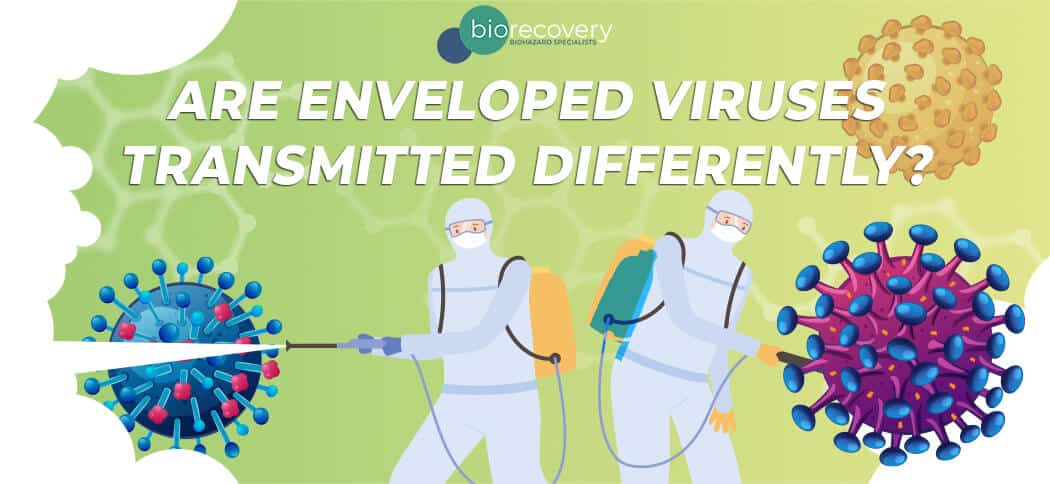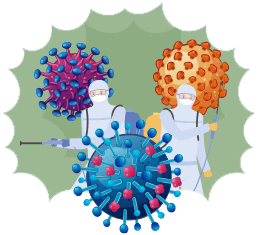Key-Points
Enveloped vs Non-Enveloped Viruses
How is Hepatitis Transmitted?
Facts About HIV Transmission
How is Influenza Spread?
The war on deadly viruses continues. To fully understand why and how deadly viruses are sanitized, you'll want to be a little familiar with how enveloped and non-enveloped viruses are transmitted.
We recently discussed the transmission of non-enveloped viruses, but what about enveloped viruses? Enveloped viruses are another class of potentially deadly viruses that we disinfect daily.
Enveloped viruses differ from non-enveloped viruses because of their outer coating that makes them appear “enveloped”, which gives them a distinct look and name. The envelope coating is what helps them “hook” onto a cell to infect the host.
Enveloped viruses have harmful rDNA material protruding from the cell, making them more susceptible to disinfectants than nonenveloped viruses.
However, just like non-enveloped viruses, the transmission of enveloped viruses varies depending on the virus itself. Direct contact or inhalation is the most common.
What is an Enveloped Virus?
- Hepatitis
- HIV
- Influenza
How is Hepatitis Transmitted?
Hepatitis is transmitted from several different viruses, and classified by Hepatitis strains A, B, C, D, and E. All strains attack the liver, and because millions don’t know they have this highly infectious virus, small outbreaks happen all the time.
Hep A and E are the only two that have a short-term lifespan, although Hep E can cause serious problems for pregnant women. Each classification is transmitted differently, but the transmission of Hep B and C is similar.
Hepatitis A is usually caused by contact with a food or water source contaminated by feces infected by hepatitis A (HAV) virus.
Transmission of Hepatitis B and C
Hepatitis B and C are both transmitted when contact is made with infected body fluids. This could be contact with infected blood, vaginal secretions, or semen. Hep C, however, is more commonly spread through blood-to-blood contact. Both can be transmitted through sexual contact and shared dirty needles, but this transmission is more common with Hep B.
Transmission of Hepatitis D
Hepatitis D, also called delta hepatitis, is the most serious strain of hepatitis. Hepatitis D is transmitted from blood-to-blood contact only and must have Hepatitis B present in order to grow. Because hepatitis D infects in conjunction with hepatitis B (HBV), the hep D fatality rate is 20%.
Transmission of Hepatitis E
Hepatitis E develops after contact with the Hepatitis E (HEV) virus. This virus is transmitted in poorly sanitized areas that have infected fecal matter in water. Unknowingly drinking this contaminated water will lead to the infection of this virus.
Did you know?
Autoimmune hepatitis and alcoholic hepatitis share similar symptoms as viral hepatitis strains but are not viral in nature. Alcoholic hepatitis is the result of alcohol abuse on the liver, whereas autoimmune hepatitis is the immune system mistakenly attacking the liver.
Non-viral hepatitisHepatitis has to be treated properly, depending on the strain and spread of the situation. To read more on proper disinfection procedures after suspected exposure, please read more here.
Facts About HIV Transmission
You’ve probably heard of HIV, or human immunodeficiency virus. Since the early 1980s, HIV has been infecting those that share dirty needles or practice unprotected sex with an infected partner.
The dangerous thing about this virus is that it attacks the body’s immune system while disguising itself as a blood cell. Left untreated, the virus damages the immune system to the point of AIDs. AIDs is an incurable disease that leaves the body severely vulnerable to further infections.
How is Influenza Spread?
Influenza, or the flu, is often spread by respiratory droplets, but contact with a contaminated surface, skin-to-skin contact, and contact with infected saliva are additional methods of transmission. Flu symptoms are sometimes confused with colds, but flu symptoms are usually more abrupt.
Flu symptoms can also be potentially life-threatening. This is because when influenza attacks the respiratory tract of immunocompromised people, they are even more susceptible to developing serious respiratory complications such as pneumonia.
Did you know?
Bioscientists have reconstructed the 1918 influenza virus pandemic in a lab setting to prepare for future pandemics.
Influenza VirusConcerned About an Outbreak?
Share this Post






